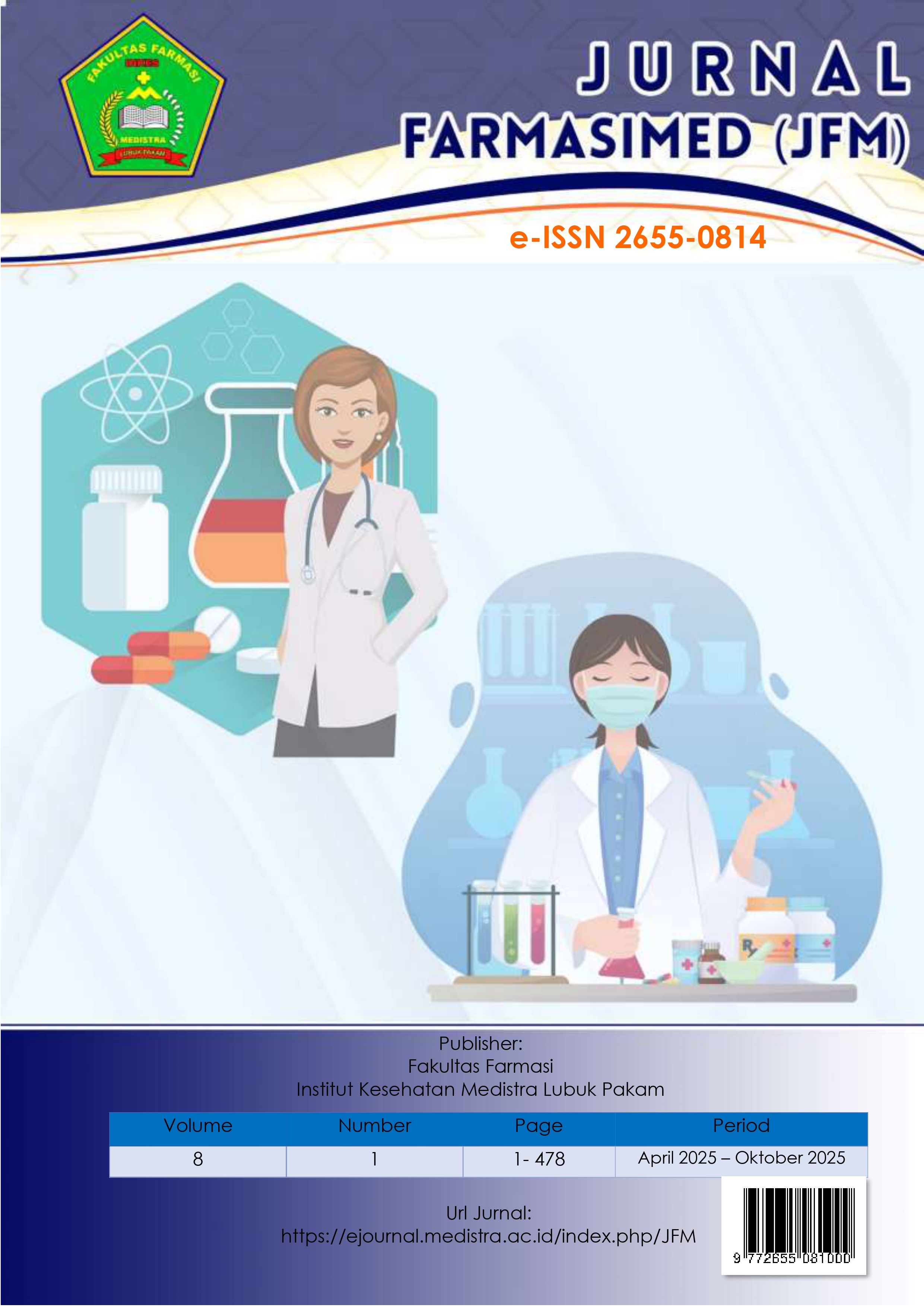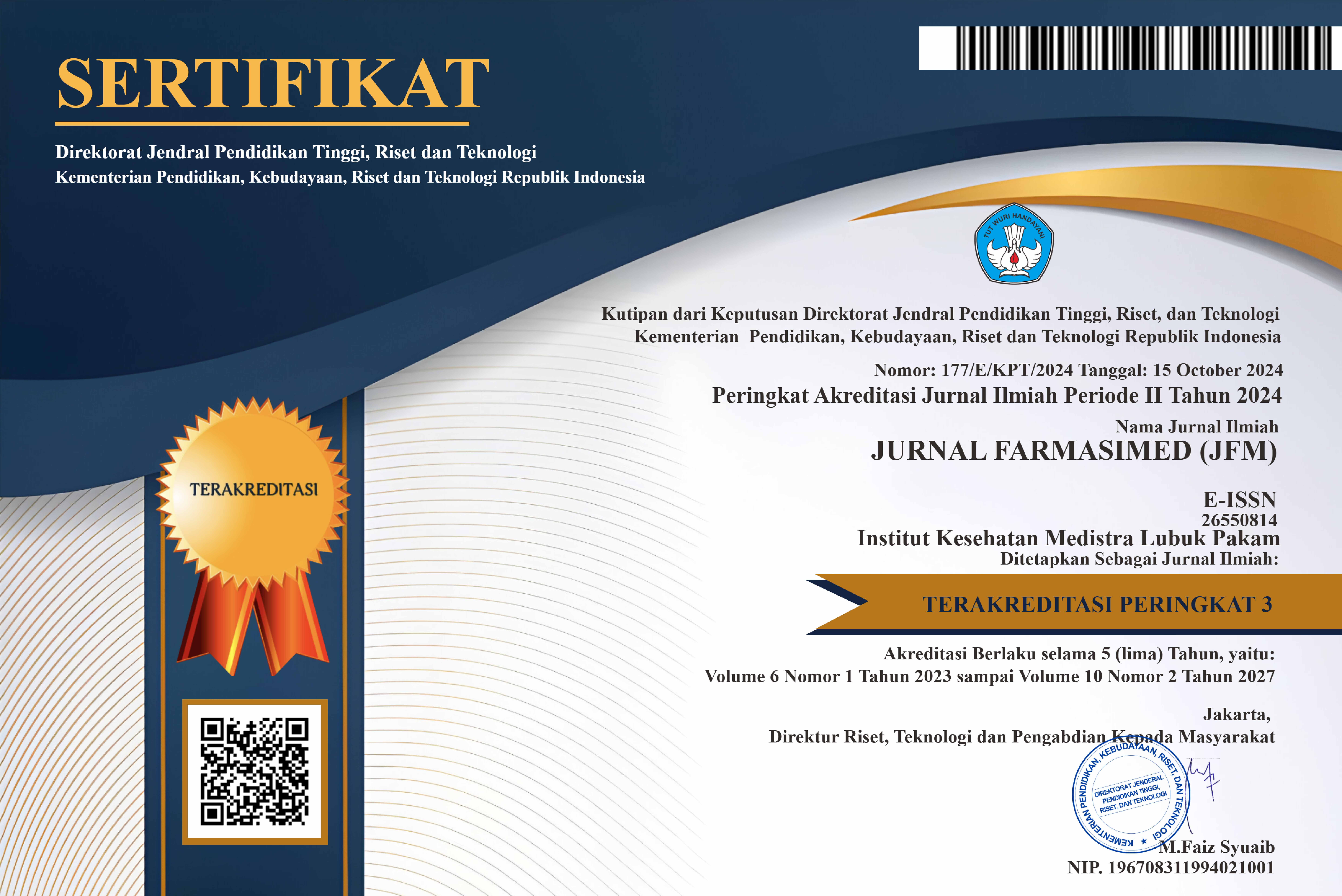Antioxidant Potential of the Asteraceae Family in Counteracting Free Radicals in Cigarette Smoke: An Overview
DOI:
https://doi.org/10.35451/4vbm3x10Keywords:
asteraceae, Asteraceae, Cigarette smoke, Natural antioxidants, Lung biomarkers, Oxidative stress, Systematic reviewAbstract
Cigarette smoke exposure triggers oxidative stress in the respiratory system through an increase in free radicals and a decrease in endogenous antioxidant activity, which contributes to lung damage and chronic diseases such as COPD and lung cancer. This study aims to investigate the potential of species from the Asteraceae family as a source of natural antioxidants in protecting the lungs and trachea from damage caused by exposure to free radicals in cigarette smoke. The method used is a Systematic Literature Review (SLR) with reference to the PRISMA 2020 guidelines. Literature searches were conducted systematically through the PubMed, ScienceDirect, and Google Scholar databases until June 2025. The inclusion criteria included in vivo studies using Asteraceae plant extracts in animals with induced oxidative stress in the respiratory system, as well as involving the measurement of biomarkers such as MDA, GSH, SOD, and CAT. Of the 198 articles found, 10 articles met the criteria and included species such as Tridax procumbens, Chromolaena odorata, Pulicaria petiolaris, and Baccharis retusa. The results showed that these species had significant antioxidant activity through their flavonoid, polyphenol, and triterpenoid compound content. However, most studies did not use a direct cigarette smoke exposure model. In conclusion, the Asteraceae family has great potential as a source of natural antioxidants to protect the respiratory system from oxidative stress, although further research with more relevant exposure models is needed. Toxicology and metabolomics approaches are also needed to strengthen the evidence for practical application in the treatment of lung diseases caused by cigarette smoke.
Downloads
References
[1] A. Pandi, V. Lal, B. Chakraborty, and V. M. Kalappan, “Evaluation of Oxidative Stress and Antioxidant Biomarkers in Chronic Cigarette Smokers: A Pilot Study,” Cureus, May 2024, doi: 10.7759/cureus.60629.
[2] E. Zinellu et al., “Oxidative Stress Biomarkers in Chronic Obstructive Pulmonary Disease Exacerbations: A Systematic Review,” Antioxidants, vol. 10, no. 5, p. 710, Apr. 2021, doi: 10.3390/antiox10050710.
[3] K. Devi, S. Soni, V. Tripathi, R. Pandey, and B. Moharana, “Ethanolic Extract of Tridax procumbens Mitigates Pulmonary Inflammation via Inhibition of NF-κB/p65/ERK Mediated Signalling in an Allergic Asthma Model,” Phytomedicine, vol. 99, p. 154008, May 2022, doi: 10.1016/j.phymed.2022.154008.
[4] R. Ahmadkhaniha, F. Yousefian, and N. Rastkari, “Impact of smoking on oxidant/antioxidant status and oxidative stress index levels in serum of the university students,” J Environ Health Sci Eng, vol. 19, no. 1, pp. 1043–1046, Jun. 2021, doi: 10.1007/s40201-021-00669-y.
[5] A. Nurrohiim, H. Setiawan, D. K. Wardani, I. F. Nurazizah, and A. S. Azali, “EFEK PROTEKTIF EKSTRAK SONGGOLANGIT (Tridax procumbens L.) TERHADAP HISTOPATOLOGI ORGAN PERNAPASAN TIKUS YANG DIPAPAR ASAP ROKOK,” Ber Biol, vol. 23, no. 1, pp. 73–82, Apr. 2024, doi: 10.55981/beritabiologi.2024.2063.
[6] M. B. Majnooni et al., “Phytochemicals: Potential Therapeutic Interventions Against Coronavirus-Associated Lung Injury,” Front Pharmacol, vol. 11, Nov. 2020, doi: 10.3389/fphar.2020.588467.
[7] A. Karakuş, Y. Değer, and S. Yıldırım, “Protective effect of Silybum marianum and Taraxacum officinale extracts against oxidative kidney injuries induced by carbon tetrachloride in rats,” Ren Fail, vol. 39, no. 1, pp. 1–6, Jan. 2017, doi: 10.1080/0886022X.2016.1244070.
[8] C. C. Ikewuchi, J. C. Ikewuchi, and M. O. Ifeanacho, “Aqueous leafextracts of Chromolaena odorata and Tridax procumbens attenuated doxorubicin-induced pulmonary toxicity in Wistar rats,” BioTechnologia, vol. 102, no. 4, pp. 387–398, Dec. 2021, doi: 10.5114/bta.2021.111096.
[9] N. R. Haddaway, M. J. Page, C. C. Pritchard, and L. A. McGuinness, “PRISMA2020: An R package and Shiny app for producing PRISMA 2020-compliant flow diagrams, with interactivity for optimised digital transparency and Open Synthesis Campbell Systematic Reviews,” Campbell Systematic Reviews, vol. 18, no. 2, Jun. 2022, doi: 10.1002/cl2.1230.
[10] A. Hamad, M. Arfan, S. A. Khan, N. Fatima, A. M. Abbasi, and A. Mannan, “Evaluation of antioxidant, antimicrobial and cytotoxic potential in Artemisia vulgaris L.,” Rev Rom Med Lab, vol. 26, no. 4, pp. 431–441, Oct. 2018, doi: 10.2478/rrlm-2018-0020.
[11] B. Elangovan, A. S. Ajayakumar, and ranjani P. Anandraj, “Cardio Protective Role of Ageratum conyzoides L. on Cardiac Mitochondrial Enzymes during Isoproterenol Induced Myocardial Infarction in Rats,” Journal of Pharmacy and Pharmacology Research, vol. 6, p. 32, 2022.
[12] N. S. de Almeida et al., “Baccharis trimera aqueous extract modulates inflammation and nociception in mice,” Clinical Phytoscience, vol. 7, no. 1, p. 82, Dec. 2021, doi: 10.1186/s40816-021-00309-w.
[13] M. Kamran et al., “Hydroquinone; A Novel Bioactive Compound from Plant-Derived Smoke Can Cue Seed Germination of Lettuce,” Front Chem, vol. 5, May 2017, doi: 10.3389/fchem.2017.00030.
[14] N. Ahmed et al., “Pulicaria petiolaris effectively attenuates lipopolysaccharide (LPS)-induced acute lung injury in mice,” Arch Biol Sci, vol. 70, no. 4, pp. 699–706, 2018, doi: 10.2298/ABS180510033A.
[15] L. Taguchi et al., “A flavanone from Baccharis retusa (Asteraceae) prevents elastase-induced emphysema in mice by regulating NF-κB, oxidative stress and metalloproteinases,” Respir Res, vol. 16, no. 1, p. 79, Dec. 2015, doi: 10.1186/s12931-015-0233-3.
[16] G. Liu, Q. Zheng, K. Pan, and X. Xu, “Protective effect of Chrysanthemum morifolium Ramat. ethanol extract on lipopolysaccharide induced acute lung injury in mice,” BMC Complement Med Ther, vol. 20, no. 1, p. 235, Dec. 2020, doi: 10.1186/s12906-020-03017-z.
[17] J. Zhang, F. Zhao, X. Yu, X. Lu, and G. Zheng, “Pharmacokinetics of eupalinolide A, eupalinolide B and hyperoside from Eupatorium lindleyanum in rats by LC/MS/MS,” Journal of Chromatography B, vol. 995–996, pp. 1–7, Jul. 2015, doi: 10.1016/j.jchromb.2015.04.038.
[18] X. Li et al., “Scutellarein Suppresses the Production of ROS and Inflammatory Mediators of LPS-Activated Bronchial Epithelial Cells and Attenuates Acute Lung Injury in Mice,” Antioxidants, vol. 13, no. 6, p. 710, Jun. 2024, doi: 10.3390/antiox13060710.
[19] S.-R. Cha, J. Jang, S.-M. Park, S. M. Ryu, S.-J. Cho, and S.-R. Yang, “Cigarette Smoke-Induced Respiratory Response: Insights into Cellular Processes and Biomarkers,” Antioxidants, vol. 12, no. 6, p. 1210, Jun. 2023, doi: 10.3390/antiox12061210.
[20] N. Lu et al., “Preventive Effect of Arctium lappa Polysaccharides on Acute Lung Injury through Anti-Inflammatory and Antioxidant Activities,” Nutrients, vol. 15, no. 23, p. 4946, Nov. 2023, doi: 10.3390/nu15234946.
Downloads
Published
Issue
Section
License
Copyright (c) 2025 Aulia Syafadilla Azali, Muhammad Andy Rajab, Sofiani Lathifah, Akrom

This work is licensed under a Creative Commons Attribution-NoDerivatives 4.0 International License.
Copyright in each article is the property of the Author.

























